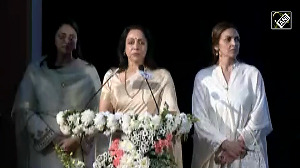HAL has integrated the ASRAAM (advanced short range air-to-air missile) for the Tejas Mark 1A.
The Tejas Mark 1A will carry twin ASRAAM missiles with a range of 60 to 70 kilometres.

The first Tejas Mark-1A fighter aircraft took to the skies from the Hindustan Aeronautics Limited (HAL) facility in Bengaluru on March 28, 2024.
The successful sortie, which flew for 18 minutes, was piloted by HAL's chief test pilot, Group Captain K K Venugopal (retd).
HAL stated: 'The country can look forward to early induction of the Tejas Mark-1A by the Indian Air Force and more numbers through the three lines of production established at HAL.'
'The Tejas Mark-1A will have an advanced radar, electronic warfare system, communication system, additional combat capability and improved maintenance features,' HAL stated.
The Mark-1A has four to five major changes over the Mark-1 fighter. This includes an active electronic scanned array (AESA) radar, a combined interrogator and transponder (CIT) and a digital map generator. This extracts the complete map data of the current area of operations and transfers it to the pilots' display.
The digital map generator, designed and developed by HAL's Mission and Combat Systems R&D Centre (MCSR&DC), had thermal issues and was a failure point in the Tejas Mark 1. This has been replaced with computers designed by the MCSR&DC.
In addition, HAL has integrated the ASRAAM (advanced short range air-to-air missile) for the Mark 1A's outboard stations. This is a British built MBDA missile that has been bought for the Jaguar and is being introduced into the Tejas, which will be able to carry twin ASRAAM missiles with a range of 60 to 70 kilometres.
HAL is also doing a cockpit floor modification that will enable 95 per cent of all IAF pilots, including bigger pilots, with shoe size 10, to fly the aircraft comfortably.
It will take almost two years to complete flight testing of the Tejas Mark-1A, which has had HAL pilots and IAF pilots from the national flight test centre working jointly to flight test the new fighter.
LCA Mark-2
Simultaneously development has begun on the Tejas Mark-2. This will be a bigger, more capable aircraft, with a more powerful GE F-414 engine and a maximum all-up weight of 16.5 tonnes, including about six tonnes of external payload.
Two external drop tanks would carry another 3.5 tonnes of fuel, but would reduce the carriage of external stores to just 3 tonnes.
The Tejas Mark-2 is no longer an LCA, but a totally new medium-weight fighter.
A canard has been added ahead of the wings, like in the Rafale, Eurofighter and the Sukhoi-30MKI. This provides an additional control surface, which creates a vortex that increases the lifting capability and agility of the aircraft.
The Mark-2 will see the integration of several new weapons, including the indigenous Astra Mark I and Mark II. It will also carry the Rudram anti-radiation missile developed by DRDL Hyderabad.
DRDO is also making a range of bombs for the Tejas Mark-2. This includes the Tara high speed, low drag bomb, which is mounted on the pylons.
The Mark-2 will have 11 hard points, including on the wingtips, which is for the ASRAAM close combat missile. It will have one centre-line station and two lateral stations on the side of the fuselage under-belly.
The Mark-2 will have elements of the Tejas Mark-1A, but also elements of an entirely new design.











